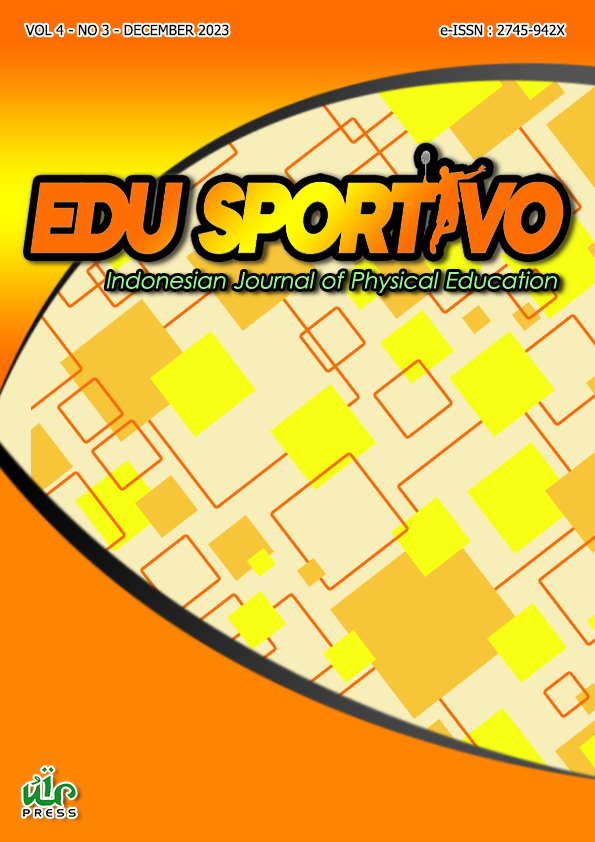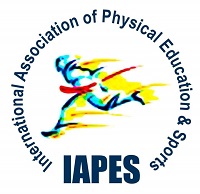Improving volleyball competence: E-module-based volleyball learning media innovation
Keywords:
E-modules, learning media, volleyballAbstract
The urgent need for the creation of cutting-edge learning media in the context of volleyball learning served as the driving force behind this study. The main objective was to develop and validate the E-Module as an innovative learning tool specifically focused on skill development in volleyball. The research method applied was the development method with the ADDIE approach (Analysis, Design, Development, Implementation, and Evaluation). Data collection was done through questionnaires and documentation, while data analysis used quantitative descriptive techniques. The results showed that E-Module as an innovative learning tool in volleyball can be developed successfully. This finding highlighted the important role of experts in the development of e-modules and opened up new insights into the potential of technology in supporting the learning of sport practices, especially in the context of volleyball. While the results of this study showed a positive impact, there are limitations in the context and sample of the study. Therefore, further research is needed to explore the impact of student motivation on the use of the E-Module in volleyball learning as well as generalise these findings to other sport learning contexts. This E-Module can not only be a reference for further research in the field of sports learning media development, especially volleyball, but also be recognised as an excellent product of E-Module-Based Volleyball Learning. Thus, this research contributes not only to academic knowledge but also to the practice of sports learning, especially volleyball.
Downloads
References
Afif, M., Mohd, B., Mansor, R. B., Afif, M., Mohd, B., & Mansor, R. B. (2023). Development and Validation of Teaching and Learning Module Based on Addie Model for Year 4 Plant Topic Development and Validation of Teaching and Learning Module Based on Addie Model for Year 4 Plant Topic. International Journal of Academic Research in Progressive Education and Development, 12(2), 1413–1428. https://doi.org/10.6007/IJARPED/v12-i2/17338
Afriyanti, M., Suyatna, A., & Viyanti. (2021). Design of E-Modules to Stimulate HOTS on Static Fluid Materials with the STEM Approach. Journal of Physics: Conference Series, 1788(1), 1–8. https://doi.org/10.1088/1742-6596/1788/1/012032
Alfani, S., Damrah, D., Wahyuri, A. S., & Sepriadi, S. (2023). Pengembangan E-Modul untuk Materi Bola Voli. Jurnal JPDO, 6(3), 23–31.
Asrial, Syahrial, Kurniawan, D. A., Chan, F., Septianingsih, R., & Perdana, R. (2019). Multimedia Innovation 4.0 in Education: E-Modul Ethnoconstructivism. Universal Journal of Educational Research, 7(10), 2098–2107. https://doi.org/10.13189/ujer.2019.071007
Astalini, Darmaji, Kurniawan, W., Anwar, K., & Kurniawan, D. A. (2019). Effectiveness of Using E-Module and E-Assessment. International Journal of Interactive Mobile Technologies, 13(9), 21–39. https://doi.org/10.3991/ijim.v13i09.11016
Batubara, R., Bafirman, B., Wahyuri, A. S., Ihsan, N., & Fadlan, A. R. (2022). Development of Sports and Health Physical Education Learning E-Module Pencak Silat Material Accompanied by Physical Fitness Exercise Activities for Class VII Students. International Journal of Education and Literature, 1(3), 74–82. https://doi.org/doi.org/10.55606/ijel.v1i3.47
Boichuk, R., Iermakov, S., & Nosko, M. (2017). Pedagogical Conditions of Motor Training of Junior Volleyball Players during the Initial Stage. Journal of Physical Education and Sport, 17(1), 327–334. https://doi.org/10.7752/jpes.2017.01048
Çelik, A. (2020). A Systematic Review on Examination of E-Learning Platforms in Sports Education. African Educational Research Journal, 8(2), 292–296. https://doi.org/10.30918/aerj.82.20.058
Cruz, J. J. P., Ricalde, A. M., & Closa, J. M. (2021). Module Development for Online Physical Education Classes: Teachers’ Perspective and Experiences. ACM International Conference Proceeding Series, 151–156. https://doi.org/10.1145/3450148.3450153
Darmaji, D., Komaini, A., Inarta, G. U., Kiram, P. Y., Handayani, S. G., & Padli, P. (2022). How is the Relationship Between Student Responses and Students’ Motor Skills after using the Cat vs Fish Game E-Module?. Cypriot Journal of Educational Sciences, 17(11), 4000–4018. https://doi.org/10.18844/cjes.v17i11.8429
DiVerniero, R. A., & Hosek, A. M. (2011). Students’ Perceptions and Communicative Management of Instructors’ Online Self-Disclosure. Communication Quarterly, 59(4), 428–449. https://doi.org/10.1080/01463373.2011.597275
Dubey, P., Pradhan, R. L., & Sahu, K. K. (2023). Underlying Factors of Student Engagement to E-Learning. Journal of Research in Innovative Teaching and Learning, 16(1), 17–36. https://doi.org/10.1108/JRIT-09-2022-0058
El-Sabagh, H. A. (2021). Adaptive E-Learning Environment Based on Learning Styles and its Impact on Development Students’ Engagement. International Journal of Educational Technology in Higher Education, 18(1). https://doi.org/10.1186/s41239-021-00289-4
Erianti, E., Pitnawati, P., Astuti, Y., Zulbahri, Z., Damrah, D., & Sari, D. N. (2022). The A-Practicum Module Development of Adaptive Physical Education Courses. Linguistics and Culture Review, 6(2), 450–464. https://doi.org/10.21744/lingcure.v6ns2.2137
Fani, R. A., & Sukoco, P. (2019). Volleyball Learning Media using Method of Teaching Games for Understanding Adobe Flash-Based. Psychology, Evaluation, and Technology in Educational Research, 2(1), 34. https://doi.org/10.33292/petier.v2i1.6
Geisen, M., Fox, A., & Klatt, S. (2023). VR as an Innovative Learning Tool in Sports Education. Applied Sciences (Switzerland), 13(4), 1–11. https://doi.org/10.3390/app13042239
Gumara, O. H., Wahyuri, A. S., Damrah, & Ihsan, N. (2023). Effectiveness of E-Modules for Physical Education, Sports and Health Subjects in Improving Learning Outcomes of Junior High School Students. Edumaspul: Jurnal Pendidikan, 7(1), 1320–1327. https://doi.org/10.33487/edumaspul.v7i1.6037
Gustafson, K. L., & Branch, R. M. (1997). Revisioning Models of Instructional Development. Educational Technology Research and Development, 45(3), 73–89. https://doi.org/10.1007/BF02299731
Habibi, M., Sunardi, & Sudiyanto. (2022). Identification of Opportunities for Utilizing E-Modules with a Problem Based Learning Approach to Facilitate Learning in Vocational High Schools. Jurnal Edutech Undiksha, 10(2), 311–322. https://doi.org/10.23887/jeu.v10i2.52722
Ismailova, A. (2022). Volleyball is a Popular Game in Many Countries around the World. ACADEMICIA: An International Multidisciplinary Research Journal, 12(10), 75–85. https://doi.org/10.5958/2249-7137.2022.00809.6
Jacob, S., Delatouche, B., Péré, D., Ullah Khan, Z., Ledoux, M. J., Crispin, X., & Chmielowski, R. (2021). High-Performance Flexible Thermoelectric Modules Based on High Crystal Quality Printed TIS2/Hexylamine. Science and Technology of Advanced Materials, 22(1), 907–916. https://doi.org/10.1080/14686996.2021.1978802
Johan, R. C., Rullyana, G., & Ardiansah, A. (2022). Hyper Content E-Module in Information Behavior Course with the Assistant of Screencast. Journal of Education and Learning (EduLearn), 16(2), 210–218. https://doi.org/10.11591/edulearn.v16i2.20339
Kaden, U. (2020). COVID-19 School Closure-Related Changes to the Professional Life of a K–12 Teacher. Education Sciences, 10(6), 1–13. https://doi.org/10.3390/educsci10060165
Leary, M. P., Leary, B., & Sherlock, L. A. (2022). Evaluating 5% Healthier: An e-Service-Learning Teleexercise Program for Undergraduate and Graduate Students in Exercise Physiology. Education Research International, 2022, 1–10. https://doi.org/10.1155/2022/2889945
Lestari, H. D., Martatiyana, D. R., & Usman, H. (2023). Application of the Addie Model in Designing Digital Teaching Materials. Jurnal Pendidikan dan Pengajaran Guru Sekolah Dasar (JPPGuseda), 6(1), 105–109. https://doi.org/10.55215/jppguseda.v6i1.7525
Li, K. C., & Wong, B. T. (2019). How Learning Has Been Personalised : A Review of Literature from 2009 to 2018. In S. Cheung, L. Lee, I. Simonova, T. Kozel, & L. Kwok (Eds.), Blended Learning: Educational Innovation for Personalized Learning (pp. 72–81). Springer International Publishing. https://doi.org/10.1007/978-3-030-21562-0
Li, K. C., & Wong, B. T. M. (2021). Features and Trends of Personalised Learning: a Review of Journal Publications from 2001 to 2018. Interactive Learning Environments, 29(2), 182–195. https://doi.org/10.1080/10494820.2020.1811735
Martatiyana, D. R., Usman, H., & Lestari, H. D. (2023). Application of the Addie Model in Designing Digital Teaching Materials. Jurnal Pendidikan dan Pengajaran Guru Sekolah Dasar (JPPGuseda), 6(1), 105–109. https://doi.org/10.55215/jppguseda.v6i1.7525
McCosker, C., Otte, F., Rothwell, M., & Davids, K. (2022). Principles for Technology Use in Athlete Support Across the Skill Level Continuum. International Journal of Sports Science and Coaching, 17(2), 437–444. https://doi.org/10.1177/17479541211033471
Nor, W., Wan, A., Ahmad, W., & Wan, J. (2023). Waterfall-ADDIE Model: An Integration of Software Development Model and Instructional Systems Design in Developing a Digital Video Learning Application. Asean Journal of Teaching and Learning in Higher Education, 15(1), 1–28. https://doi.org/10.17576/ajtlhe.1501.2023.01
Özgül, F., Atan, T., & Kangalgil, M. (2019). Comparison of the Command and Inclusion Styles of Physical Education Lessons to Teach Volleyball in Middle School. The Physical Educator, 76(1), 182–196. https://doi.org/10.18666/tpe-2019-v76-i1-8481
Rajabalee, Y. B., & Santally, M. I. (2021). Learner Satisfaction, Engagement and Performances in an Online Module: Implications for Institutional E-Learning Policy. Education and Information Technologies, 26(3), 2623-2656. https://doi.org/10.1007/s10639-020-10375-1
Rosmawati, R., Zarwan, Z., Astuti, Y., Sari, D. N., Zulbahri, Z., & Erianti, E. (2022). E-Module Design of Sport Modification and Cybergogy-Based Small Games. Linguistics and Culture Review, 6(3), 264–274. https://doi.org/10.21744/lingcure.v6ns3.2143
Samsuddin, S., Indra, K., & Herli, P. (2022). The Effectiveness of E-Learning-Based Volleyball Service Video Media on Students Affected By Covid-19 At Faculty of Sports Science, Universitas Negeri Medan. Physical Education Theory and Methodology, 22(1), 7–13. https://doi.org/10.17309/TMFV.2022.1.01
Sidiq, R., & Suhendro, P. (2021). Utilization of Interactive E-Modules in Formation of Students’s Independent Characters in the Era of Pandemic. International Journal of Educational Research and Social Sciences (IJERSC), 2(6), 1651–1657. https://doi.org/10.51601/ijersc.v2i6.194
Subakty, W. B., Suwirman, Ihsan, N., Sepriadi, S. (2022). Desain E-modul Bolavoli berbasis Andorid pada Mata Pelajaran Pendidikan Jasmani Olahraga dan Kesehatan Kelas VII SMP. Jurnal Pendidikan dan Olahraga, 5(10), 162–167.
Sulaeman, N. F., Triwulandari, S., & Syam, M. (2022). Development of Stem-Based Teaching Materials With Engineering Design Process Model on Global Warming: Validity Aspect. Jurnal Pembelajaran Fisika, 11(2), 69-79. https://doi.org/10.19184/jpf.v11i2.31534
Suripto, A. W. (2019). Effectiveness E-Module in PJKR Students Hurdles Learning. 5th International Conference on Physical Education, Sport, and Health, 362, 167–169. https://doi.org/10.2991/acpes-19.2019.37
Tan, P. J. B. (2019). An Empirical Study of How the Learning Attitudes of College Students toward English E-Tutoring Websites Affect Site Sustainability. Sustainability, 11(6), 1–19. https://doi.org/10.3390/su11061748
Tian, Y. (2020). Innovation Research of the “Internet plus” Volleyball Teaching System under the Background of Information Age. International Journal of Sports Technology, 1(4), 1–21. https://doi.org/10.38007/ijst.2020.010403
Townley, A. L., Soares, L. B., & Rahimi, R. (2023). Ready or Not? A Pilot Study of Graduate Students’ and Instructors’ Perceptions of the Effectiveness of Online Support Modules for Enhancing Academic Performance. Education Sciences, 13(7), 656. https://doi.org/10.3390/educsci13070656
Velan, G. M., Goergen, S. K., Grimm, J., & Shulruf, B. (2015). Impact of Interactive e-Learning Modules on Appropriateness of Imaging Referrals: A Multicenter, Randomized, Crossover Study. Journal of the American College of Radiology, 12(11), 1207–1214. https://doi.org/10.1016/j.jacr.2015.06.026
Wulandari, A. M., & Wibowo, A. K. (2022). Pengembangan Elektronik Modul Olahraga Petanque Berbasis Android. MULTILATERAL: Jurnal Pendidikan Jasmani Dan Olahraga, 21(1), 57–70. https://doi.org/10.20527/multilateral.v21i1.11324
Yulia, E., Riadi, S., & Nursanni, B. (2023). Validity of Interactive Multimedia on Metal Coating Learning Developed using the ADDIE Model. Jurnal Penelitian Pendidikan IPA, 9(5), 3968–3974. https://doi.org/10.29303/jppipa.v9i5.3772
Published
How to Cite
Issue
Section
Copyright (c) 2023 Indra Kasih, Eva Faridah, Onyas Widianingsih, Albadi Sinulingga, Amirzan

This work is licensed under a Creative Commons Attribution-ShareAlike 4.0 International License.
This is an open-access article distributed under the terms of the Creative Commons Attribution-ShareAlike 4.0 International License which permits unrestricted use, distribution, and reproduction in any medium. Users are allowed to read, download, copy, distribute, search, or link to full-text articles in this journal without asking by giving appropriate credit, provide a link to the license, and indicate if changes were made. All of the remix, transform, or build upon the material must distribute the contributions under the same license as the original.
Accepted 2023-12-02
Published 2023-12-19








.png)




















.png)







.png)





